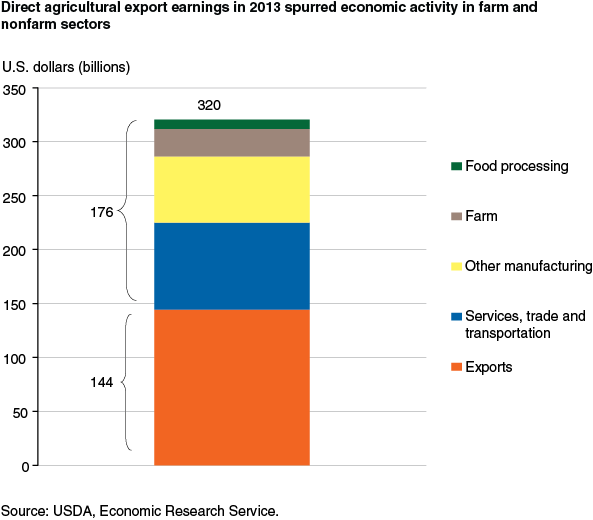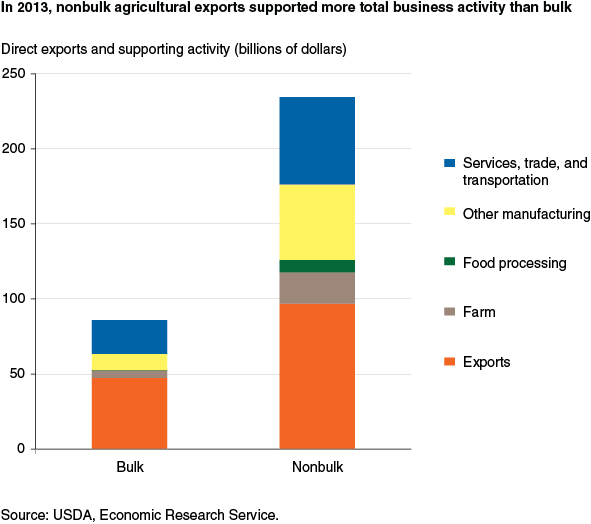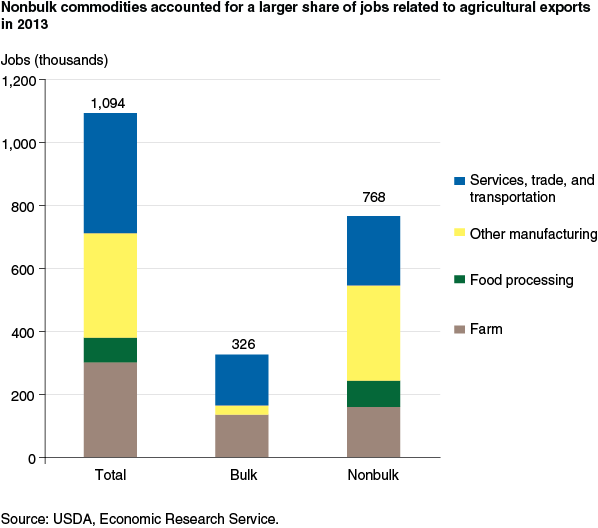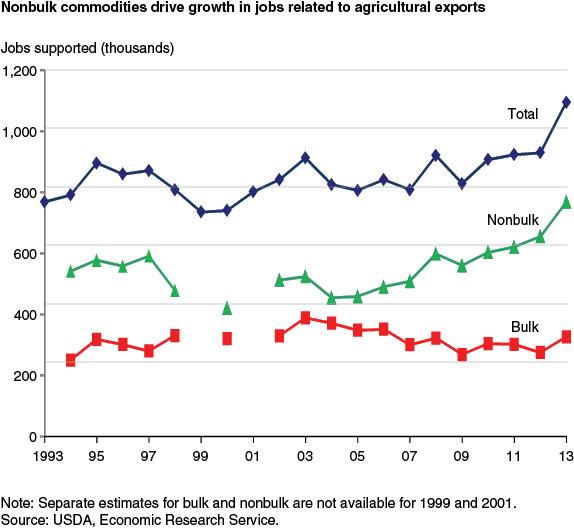Calculating the Jobs Associated With U.S. Agricultural Exports
- by Suresh Persaud
- 5/4/2015
U.S. agricultural exports affect the overall domestic economy; farmers’ purchases of fuel, fertilizer, and other inputs to produce commodities for export spur economic activity in the manufacturing, trade, and transportation sectors. Data processing, financial, legal, managerial, administrative, and many other types of services are needed to facilitate the movement of export commodities. Each year, ERS estimates agricultural trade multipliers (ATM) to measure employment and output effects of trade in farm and food products on the U.S. economy.
In calendar year 2013, the $144.38 billion of U.S. agricultural exports produced an additional $176 billion in economic activity for a total of $320.3 billion of economic output. Of total indirect activity, services, transportation, and trade generated $80.5 billion.
Non-bulk (processed or high-value) commodities account for about 67 percent of total agricultural exports and typically generate more than two and a half times as much economic activity as bulk commodities such as soybeans and other oilseeds, wheat, rice, corn and other feed grains, tobacco, and cotton. In 2013, bulk exports valued at $47.5 billion produced an additional $38.3 billion of business activity—each dollar of bulk exports generated $0.81 of additional output. Non-bulk exports of $96.9 billion stimulated an additional $137.7 billion of business activity, meaning that each dollar of non-bulk exports generated $1.42 of additional output. On average, each dollar of total agricultural exports (bulk and non-bulk combined) produced an additional $1.22 of business activity.
Total agricultural exports supported 1,094,400 full-time civilian jobs in 2013, including 793,900 jobs in the non-farm sector. Non-bulk exports have a larger proportional effect on jobs than bulk exports because they generate more economic activity and jobs in the non-farm economy, especially in manufacturing, trade, and transportation. In 2013, non-bulk exports supported an estimated 768,000 jobs or approximately 70 percent of the total, with the rest (326,000 jobs) supported by bulk exports.
The impacts of agricultural trade on the U.S. economy can change from year to year. The number of U.S. jobs associated with agricultural exports has generally been growing along with U.S. agricultural exports. However, factors beyond just the total value of exports affect ERS estimates of the trade multipliers. Changes in the composition of the agricultural exports between bulk and nonbulk agricultural products lead to differing direct and indirect impacts on the economy. Productivity growth tends to reduce the size of the trade multipliers—increasing labor productivity means that the same output can be produced with a smaller workforce or more output can be produced with the same size workforce. The structure of the U.S. economy also changes over time, influencing the domestic impacts of agricultural exports.
The number of jobs associated with total agricultural exports grew rather slowly between 2004 and 2012. That sluggish growth can be traced to a decline in jobs supported by exports of bulk commodities that began in 2004 and lasted through 2012, despite continuing growth in the value of bulk exports. In 2013, however, the total number of jobs is estimated to be about 18 percent higher than the previous year, reflecting the adoption of the rebased model.
Agricultural trade multipliers are estimated from an Input-Output framework that captures economic linkages between agriculture and the rest of the economy. ERS updates productivity estimates and the value and commodity composition of agricultural exports each year when developing annual estimates of the trade multipliers. ERS obtains data on U.S. agricultural exports from Foreign Agricultural Trade of the United States (FATUS). The FATUS definition of agricultural trade includes nonfarm exports from food processing, pharmaceutical, adhesive, and organic chemicals sectors. Consequently, ERS estimates of employment and output multipliers will differ from estimates that restrict their definition of exports to production agriculture. Moreover, the broader FATUS definition of agriculture allows ERS to estimate and compare trade multipliers for bulk versus nonbulk commodities.
Information on the changing structure of the U.S. economy, which ERS obtains from the Bureau of Economic Analysis (BEA), is not available on an annual basis. With the release of the BEA 2007 Benchmark Input Output (I/O) accounts, ERS rebased the ATM model to incorporate the most recently available set of interrelationships between the various sectors of the U.S. economy. This rebased model was used to estimate the 2013 trade multipliers.
Rebasing led not only to an increase in the magnitude of the 2013 trade multiplier but also to changes in the distribution of economic activity related to agricultural exports. The adoption of the new base is associated with reallocations of employment across different sectors of the economy. In 2013, nonfarm employment is estimated to be higher than the previous year; estimated 2013 farm-sector employment is lower. Overall, total employment is higher, as gains in nonfarm jobs overshadow losses in farm jobs.
This article is drawn from:
- Agricultural Trade Multipliers. (n.d.). U.S. Department of Agriculture, Economic Research Service.





